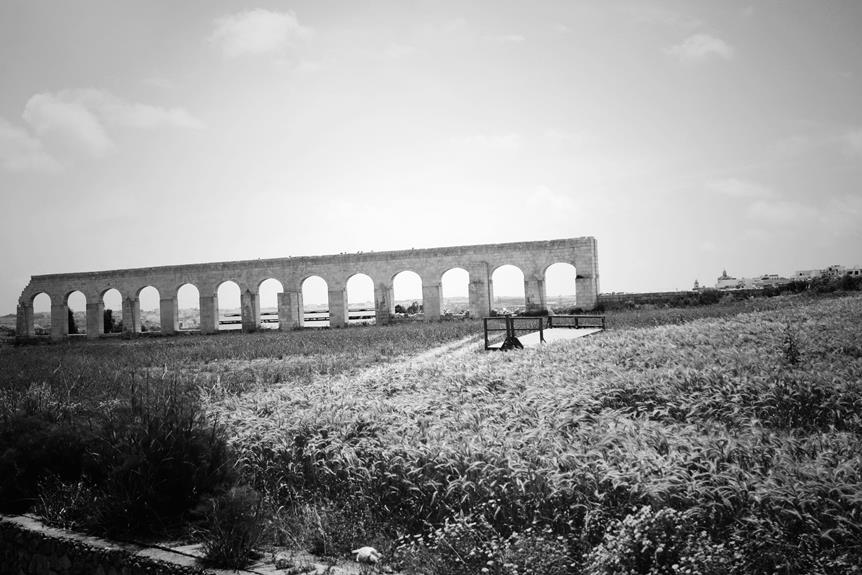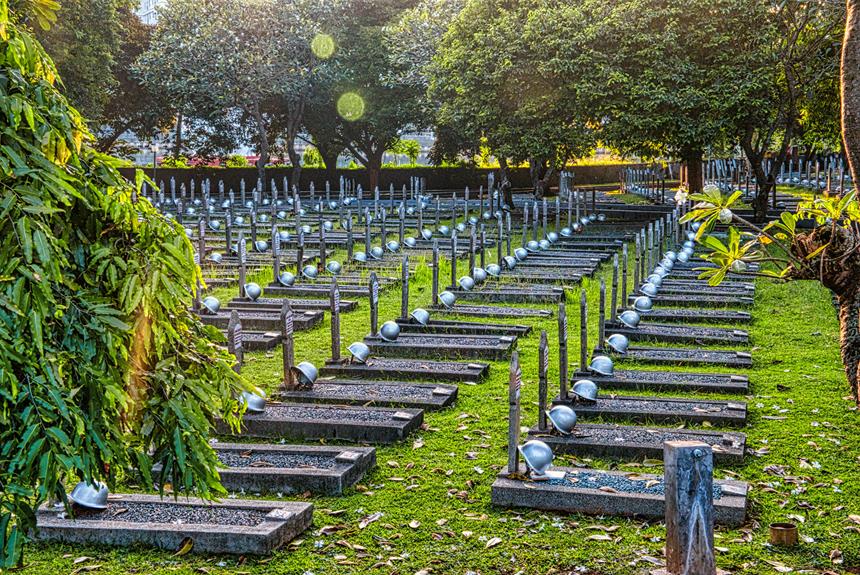The Cambodian Killing Fields in Cambodia evoke a somber reflection on the atrocities that transpired during the Khmer Rouge regime. The sheer scale of suffering and loss experienced at these sites is both haunting and profound. As we explore the origins of this dark chapter in Cambodian history, the methods of mass executions employed, and the enduring impact on survivors, a deeper understanding of the human capacity for cruelty and resilience emerges. However, the question remains: How can we guarantee that the lessons learned from the Cambodian Killing Fields are not merely relegated to the past but serve as a beacon for future generations?
Key Takeaways
- Khmer Rouge regime led mass executions
- Methods included shootings and brutal killings
- Survivors share harrowing stories of atrocities
- Memorials like Tuol Sleng Museum honor victims
- Educational initiatives raise awareness and preserve history
Origins of the Khmer Rouge Regime
The Khmer Rouge regime, responsible for the atrocities in the Cambodian Killing Fields, emerged in the context of Cambodia's tumultuous political landscape during the late 1960s and early 1970s. Led by Pol Pot, the Khmer Rouge rose to power in 1975 after a brutal civil war. The regime's ideological roots can be traced back to a radical form of communism influenced by Maoism.
The rise to power of the Khmer Rouge was facilitated by a combination of factors, including the destabilization caused by the Vietnam War and the internal political struggles within Cambodia. Exploiting the vulnerabilities of the existing government, the Khmer Rouge capitalized on the dissatisfaction among the rural population to garner support for their cause.
The ideological foundations of the Khmer Rouge were deeply rooted in a desire to create an agrarian utopia through a radical form of communism. This vision was fueled by a belief in the need to eliminate class distinctions and create a society based on agricultural labor. However, the implementation of these ideals led to widespread suffering, as the regime engaged in mass executions, forced labor, and brutal repression.
Construction of the Killing Fields
Amidst the ideological fervor and political upheaval that characterized the Khmer Rouge regime's ascent to power, the construction of the Killing Fields emerged as a chilling manifestation of their brutal methods of control and repression. The Khmer Rouge utilized forced labor as a central tool in the construction of these sites, exploiting the population to execute their sinister vision. Through propaganda tactics, they manipulated individuals into believing that the construction of the Killing Fields was a necessary step towards building a new society, ultimately leading to the devastation that unfolded within these grounds.
To provide a clearer picture, the table below outlines some key aspects of the construction of the Killing Fields:
| Aspect | Description | Impact |
|---|---|---|
| Forced Labor | Civilians, including women and children, forced to work in harsh conditions | Physical and psychological trauma inflicted |
| Propaganda Tactics | Manipulation of individuals through indoctrination and false promises | Deception and control over the population |
| Site Selection | Strategic locations chosen for isolation and secrecy | Facilitated mass atrocities away from public view |
| Infrastructure | Basic facilities built to support execution operations | Streamlined the process of mass killings |
The construction of the Killing Fields stands as a stark reminder of the lengths to which oppressive regimes can go in their quest for power and control. Through the ruthless implementation of forced labor and manipulative propaganda tactics, the Khmer Rouge inflicted unimaginable suffering on the Cambodian people, forever staining the pages of history with their atrocities.
Methods of Mass Executions
During the harrowing reign of the Khmer Rouge regime in Cambodia, a systematic implementation of various methods marked the chilling efficiency of mass executions within the Killing Fields. The Khmer Rouge utilized brutal and inhumane techniques to exterminate perceived enemies and anyone deemed a threat to their regime. One of the primary methods employed was mass shootings, where victims were lined up near mass graves and shot, their bodies falling directly into the pits. This method not only resulted in the immediate death of the victims but also facilitated the disposal of the bodies.
In addition to mass shootings, the Khmer Rouge also resorted to other killing methods such as bludgeoning, stabbing, and strangulation. These methods were often used when ammunition was scarce or when the regime sought to inflict more prolonged suffering on the victims. The killers showed no mercy, using whatever means necessary to achieve their goal of eliminating perceived threats.
The mass graves within the Killing Fields stand as a haunting proof of the atrocities committed during this dark period in Cambodian history. These graves serve as a stark reminder of the systematic and brutal nature of the mass executions that took place, where countless innocent lives were lost at the hands of the Khmer Rouge.
Survivors' Stories and Testimonies
Numerous firsthand accounts from individuals who survived the atrocities of the Cambodian Killing Fields provide invaluable insights into the horrors endured during the Khmer Rouge regime. These survivors' stories serve as a testimony to the resilience of the human spirit in the face of unimaginable suffering. Many survivors recount harrowing experiences of forced labor, starvation, torture, and loss of loved ones. Despite the trauma they faced, these individuals have shown remarkable strength in sharing their testimonies, shedding light on the dark chapters of Cambodia's history.
The healing journeys of these survivors are marked by immense courage and determination to overcome their past traumas. Through counseling, support groups, and advocacy efforts, many survivors have found ways to cope with their painful memories and rebuild their lives. Some have dedicated themselves to seeking justice for the atrocities committed during the Khmer Rouge era, ensuring that future generations remember the horrors of the past.
The resilience displayed by survivors of the Cambodian Killing Fields is a reminder of the human capacity to endure and persevere in the face of unspeakable atrocities. Their stories not only honor the memory of those who perished but also inspire hope for a future where peace and justice prevail. The survivors' voices stand as a powerful attestation to the strength of the human spirit in the pursuit of truth, healing, and reconciliation.
Legacy and Memorialization Efforts
The enduring legacy of the survivors' testimonies from the Cambodian Killing Fields manifests in ongoing efforts to commemorate the victims and preserve the historical memory of the atrocities perpetrated during the Khmer Rouge regime. To guarantee the preservation of this legacy, various initiatives have been implemented, including educational programs aimed at raising awareness about the events that transpired and honoring the lives lost during this dark period in Cambodian history.
One significant aspect of these memorialization efforts is the establishment of museums and memorial sites dedicated to the victims of the Cambodian Killing Fields. These sites serve as poignant reminders of the brutality that occurred and provide a space for individuals to pay their respects and learn about the atrocities committed by the Khmer Rouge regime. Additionally, educational programs are being developed to educate future generations about the importance of preserving historical memory and the consequences of totalitarian regimes.
To further exemplify the commitment to legacy preservation, the table below outlines some of the key memorialization efforts and educational programs in place:
| Initiative | Description | Impact |
|---|---|---|
| Tuol Sleng Genocide Museum | Former prison turned into a museum displaying Khmer Rouge crimes and atrocities. | Raises awareness and educates visitors. |
| Choeung Ek Genocidal Center | A memorial site where thousands of victims were executed and buried in mass graves. | Commemorates the lives lost and educates visitors. |
| Documentation Center of Cambodia | Archives materials related to the Khmer Rouge regime and provides educational resources. | Preserves historical records and educates the public. |
| Educational Programs | Workshops, seminars, and educational initiatives aimed at educating individuals about the Cambodian genocide. | Promotes awareness and understanding of the atrocities committed. |
Frequently Asked Questions
How Did the International Community Respond to the Cambodian Killing Fields?
In response to the atrocities of the Cambodian Killing Fields, the international community provided aid to support victims and initiate reconciliation efforts.
International aid organizations played a pivotal role in offering humanitarian assistance and facilitating the healing process for survivors.
Reconciliation efforts aimed to foster understanding, promote justice, and work towards rebuilding trust among affected communities.
The combined support from various nations and organizations highlighted the global commitment to addressing the aftermath of such tragic events.
What Psychological Impact Did the Cambodian Genocide Have on Future Generations?
Intergenerational trauma from historical events can manifest in various psychological impacts on future generations. The transference of unhealed trauma across familial lines can lead to heightened stress, anxiety, and even PTSD symptoms in descendants.
Psychological healing involves acknowledging and addressing these inherited wounds through therapy, community support, and cultural practices. Understanding the lasting effects of past atrocities on subsequent generations is essential in promoting mental well-being and resilience in affected populations.
Are There Ongoing Efforts to Bring Justice to the Perpetrators of the Atrocities?
In the pursuit of legal accountability for past atrocities, ongoing efforts are being made to bring perpetrators to justice through truth commissions and other mechanisms.
The quest for truth and justice continues as societies grapple with the repercussions of historical injustices.
These endeavors serve as vital steps towards reconciliation and healing, shedding light on dark chapters of the past while aiming to uphold the values of freedom and justice for all.
How Has the Cambodian Government Addressed the Education About the Genocide?
In addressing education about genocide, the Cambodian government has implemented various initiatives and educational programs. These efforts aim to raise awareness, promote historical understanding, and prevent future atrocities.
Government-sponsored initiatives include curriculum revisions, memorial sites, and educational campaigns. By incorporating these programs into schools and public discourse, the government plays an important role in fostering a culture of remembrance, reconciliation, and learning from the past.
What Is the Current State of Human Rights in Cambodia Post-Genocide?
In the intricate tapestry of post-conflict societies, Cambodia's current state of human rights showcases a blend of progress and challenges. While reconciliation efforts have been undertaken to initiate a healing journey, issues persist in ensuring full respect for human rights.
The path to sustainable peace is marred by violations, highlighting the ongoing struggle for justice and equality in Cambodia's post-genocide landscape.
Conclusion
To sum up, the Cambodian Killing Fields serve as a haunting proof of the brutal regime of the Khmer Rouge, where countless lives were mercilessly taken.
The legacy of this dark period in Cambodian history continues to be remembered through efforts to memorialize the victims and educate future generations.
Like a scar on the nation's soul, the Killing Fields stand as a stark reminder of the atrocities committed, urging us to never forget the horrors that took place within its borders.


